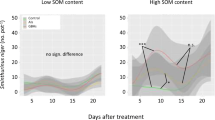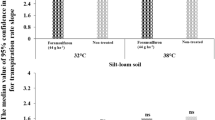Abstract
The response of introduced (Pennisetum clandestinum Hochst.) and native (Stipa aristiglumis F. Muell., Themeda australis (R. Br.) Stapf, Danthonia spp. (L.) grasses to the herbicide atrazine was studied in plants with the potential for use in vegetated filters (biofilters) designed to reduce chemical loads in agricultural runoff. The response was detected by photosynthetic inhibition using leaf chlorophyll fluorescence. With continuous short-term (14 days) dosing with atrazine in sand culture, P. clandestinum showed the greatest tolerance, regardless of the dose (20–500 μg/L). In a clay vertosol soil in the glasshouse, the four species were tolerant to longer-term (84 days) application of three successive doses of simulated run-on, each dose containing 100 μg/L atrazine, a concentration which is comparable to the highest reported in runoff from agricultural land in Australia. Even with a subsequent single atrazine dose at ∼ ∼5000 μg/L, established plants of the four species showed signs of quick recovery (7–21 days) to normal photosynthetic activity. In a field experiment with simulated run-on, applied to P. clandestinum pasture in sandy loam soil, repeated doses at concentrations up to 1000 μg/L gave no significant response; only a subsequent single dose of 5000 μg/L had significant effects, from which plants soon recovered. Although damage from atrazine can be demonstrated with continuous dosing in non-adsorbing media, in soil culture the tolerance of the four selected species to repeat doses of atrazine shows they may be used confidently for biofiltering purposes. P. clandestinum was especially tolerant.
Similar content being viewed by others
References
Aiken J T 2004 Redeveloping soil mapping key descriptors from generic soil series profiles for University of Western Sydney Hawkesbury campus soils. ISBN 1 920842 26 8 SuperSoil 2004 Published by The Regional Institute Ltd
Baconguis S E, Pameron F P and Navarro R V 1982 Grassland overgrazing degrades environment and rural life. CANOPY Int. 8
Baker J L, Mickelson S K, Arora K and Misra A K 2000 The potential of vegetated filter strips to reduce pesticide transport. American Chemical Society Symposium Series, 2000
N C W Beadle (1981) The Vegetation of Australia Press Syndicate of the University of Cambridge Cambridge
O Bjorkman B Demming (1987) ArticleTitlePhoton Yield of O2 evolution and chlorophyll fluorescence characteristics at 77K among vascular plants of diverse origin Planta 170 489–504
A Boey B Cooper (1996) Central and north-west regions water quality program – Atrazine and its ecological significance Internal Report, Department of Land and Water Conservation Australia
W L Butler M Kitajima (1975) A tripartite model for chloroplast fluorescence M Avron (Eds) Proceedings of the 3-rd International Congress on Photosynthesis Elsevier Amsterdam 13–24
I Cole T Koen J Metcalfe W Johnston M Mitchell (2003) ArticleTitleTolerance of Austrodanthonia fulva, Microlaena stipoides and Elymus scaber seedlings to nine herbicides Plant Prot. Quart. 18 18–22 Occurrence Handle1:CAS:528:DC%2BD3sXivFehsr0%3D
J D Colwell (1963) ArticleTitleThe estimation of the phosphorus fertilizer requirements of wheat in southern New South Wales Aust. J. Exp. Agr. Anim. Husb. 3 190–197 Occurrence Handle1:CAS:528:DyaF2cXnvVOhsQ%3D%3D
J R Corbett (1974) The Biochemical Mode of Action of Pesticides Academic Press London. New York
Cornish P S, Sun H and Popov V H 2004 An integrated landscape approach to biofiltration of agricultural pollutants. In Proceedings of American Water Resources Association (AWRA) Summer Specialty Conference on Riparian Ecosystems and Buffers: Multi-Scale Structure, Function, and Management, Olympic Valley CA, USA
B Gottesburen S Beulke M Heiermann W Pestemer (1994) ArticleTitleField and laboratory experiments to validate predictory models of the expert system HERBASYS applied to problems of crops following the use of herbicides Weed Res. 34 63–78
J W Gronwald (1994) Resistance to photosystem II inhibiting herbicides S B Powles J A M Holtum (Eds) Herbicide Resistance in Plants: Biology and Biochemistry Lewis Boca, FL, USA 26–60
M Dosskey (2001) ArticleTitleToward quantifying water pollution abatement in response to installing buffers on crop land Environ. Manage. 28 577–598 Occurrence Handle10.1007/s002670010245 Occurrence Handle1:STN:280:DC%2BD3MritF2rsA%3D%3D Occurrence Handle11568840
M Dosskey (2002) ArticleTitleSetting priorities for research on pollution reduction functions of agricultural buffers Environ. Manage. 30 641–650 Occurrence Handle10.1007/s00267-002-2755-y Occurrence Handle12375085
J B Dumas (1981) ArticleTitleSur les procédés de l’analyse organique Annal. de Chimie XLVII 195–213
I G Ferris T C Frecker B M Haigh S Durrant (1992) ArticleTitleHerbicide adviser: a decision support system to optimise atrazine and chlorsulfuron activity and crop safety Comput. Electron. Agr. 6 295–317
Hansatech Instruments Ltd. 1986 An introduction to fluorescence measurements with the Plant Efficiency Analyser (PEA). Narborough rd., Pentney, King’s Lynn, Norfolk PE32 1JL, England
S Houot E Topp A Yassir G Soulas (2000) ArticleTitleDependence of accelerated degradation of atrazine on soil pH in French and Canadian soils Soil Biol. Biochem. 32 615–625 Occurrence Handle10.1016/S0038-0717(99)00188-1 Occurrence Handle1:CAS:528:DC%2BD3cXjtlKjsrk%3D
R J Jettner S R Walker J D Churchett F P C Blamey S W Adkins K Bell (1999) ArticleTitlePlant sensitivity to atrazine and chlorsulfuron residues in a soil-free system Weed Res. 39 287–295 Occurrence Handle10.1046/j.1365-3180.1999.00145.x Occurrence Handle1:CAS:528:DyaK1MXmtlOru7g%3D
Jones C E 2001 The Great Salinity Debate: Part III. Soil organic matter: past lessons for future learning. Stipa Newsletter No: 15, 4–9; Reprinted in Australian Farm Journal, March 2001, 60–63
Karssies L E and Prosser I P 1999 Guidelines for riparian filter strips for Queensland irrigators.CSIRO Land and Water Technical Report, 32/99
H Kautsky A Hirsh (1931) ArticleTitleNeue versuche zur kohlenstoffassimilation Naturwissenschaften 19 964 Occurrence Handle1:CAS:528:DyaA38XhsFaguw%3D%3D
R N Lerch E M Thurman P E Blanchard (1999) ArticleTitleHydroxyatrazine in soils and sediments Environ. Toxicol. Chem. 18 2161–2168 Occurrence Handle10.1897/1551-5028(1999)018<2161:HISAS>2.3.CO;2 Occurrence Handle1:CAS:528:DyaK1MXmt1Sqsbo%3D
G M Lodge M G McMillan A J Schipp A S Cook (1994) ArticleTitleEffects of herbicides on wallaby grass (Danthonia spp.) 1. Establishment Aust. J. Exp. Agr. 34 753–757 Occurrence Handle1:CAS:528:DyaK2MXjsF2jtrg%3D
Lovett S and Price P 2001 Managing riparian lands in the sugar industry: a guide to principles and practices. Sugar Research & Development Corporation/Land & Water Australia, Brisbane. ISBN 0-9579313-0-1
Mawhinney W A 1998 Liverpool Plains water quality project – 1996/98 – land use, pesticides use and their impact on water quality in the Liverpool Plains – DLWC, December 1998, ISSN 1329–8984
McDougall K L 1989 The re-establishment of Themeda triandra (Kangaroo Grass): Implications for the restoration of grassland. Arthur Rylah Institute for Environmental Research – Technical Report Series No. 89. May 1989
Moss S R 1995 Techniques for determination of herbicide resistance. In Proceedings of Brighton Crop Protection Conference – Weeds, UK
National Registration Authority for Agricultural and Veterinary Chemicals (NRA) 1997 Technical Report on the NRA Review of Atrazine November 1997, NRA, Canberra. Available Online: www.affa.gov.au/nra/prsat.html.21
InstitutionalAuthorNameNHMRC/ARMCANZ (1996) Australian Drinking Water Quality Guidelines National Health and Medical Research Council and Agriculture and Resource Management Council of Australia and New Zealand. Resource Planning and Development Commission Australia
InstitutionalAuthorNameNRA (2002) Final Review Report on Atrazine. National Registration Authority for Agricultural and Veterinary Chemicals (NRA) NRA Chemical Review Program Australia
E J Plaster (1992) Soil Science and Management. Second Edition Delmar Publishers Inc Albany, New York, USA
Popov V, Sun H and Cornish P S 2004 Infiltration and adsorption both reduce pollutant loads in vegetative buffers. In Proceedings of American Water Resources Association (AWRA) Summer Specialty Conference on Riparian Ecosystems and Buffers: Multi-Scale Structure, Function, and Management, Olympic Valley CA, USA
Popov V, Cornish P S, Sultana K and Morris E C 2005 “Atrazine degradation in soils: the role of microbial communities, atrazine application history and soil carbon”. Aus. J. Soil Res. 43, (In press)
A Rankins SuffixJr D R Shaw M Boyette S M Seifert (1998) ArticleTitleMinimising herbicide and sediment losses in runoff from vegetative filter strips Abstr. Weed Sci. Soc. Am. 38 59
Schreiber U and Bilger W 1986 Rapid assessment of stress effect on plant leaves by chlorophyll fluorescence measurements. NATO workshop, Sesimbra, Portugal 1985
Sengalevitch G, Kuzmanov N, Alandjiiski D and Kostadinova P 1987 Triazine pollution of soil (in Bulgarian). J. Agr. Sci. 1/1987 (Abstract in English), Bulgaria
J L Stafford (1991) ArticleTitleTechniques for the establishment of kangaroo grass in South Australian conservation reserves Plant Prot. Quart. 6 120–122
USA Environmental Protection Agency (Office of Pesticides Programs) 2002 HED’s revised preliminary human health risk assessment for the re-registration eligibility decision (RED), Available on-line: http://www.epa.gov/oppsrrd1/reregistration/atrazine/hed_redchap_16apr02.PDF
USDA (United States Department of Agriculture) 2000 Conservation buffers to reduce pesticide losses. National Resource Conservation Service (NCRS), USA. Available On-line: http://www.nrcs.usda.gov/
V Vanderheyden P Debongnie L Pussemier (1997) ArticleTitleAccelerated degradation and mineralisation of atrazine in surface and subsurface soil materials Pestic. Sci. 49 237–242 Occurrence Handle10.1002/(SICI)1096-9063(199703)49:3<237::AID-PS511>3.0.CO;2-4 Occurrence Handle1:CAS:528:DyaK2sXitFKmuro%3D
Author information
Authors and Affiliations
Corresponding author
Rights and permissions
About this article
Cite this article
Popov, V.H., Cornish, P.S. Atrazine Tolerance of Grass Species with Potential for Use in Vegetated Filters in Australia. Plant Soil 280, 115–126 (2006). https://doi.org/10.1007/s11104-005-2555-2
Received:
Accepted:
Issue Date:
DOI: https://doi.org/10.1007/s11104-005-2555-2




